Community Profiles
Before examining in depth the local news consumption patterns in different types of communities, it is critical to describe the key demographic differences across their populations. Analysis shows that residents of different size communities differ on a variety of demographic, attitudinal, and behavioral measures included in the survey, many of which may be directly related to residents’ interest in local news and how they use various media to keep up with local topics of interest to them. Thus, in order to put local news consumption findings in context, community profiles highlighting key demographic, attitudinal and technology-related behavioral differences across the four community types are presented below.
Distribution across community types
The community designations that form the basis of this report are self-reported by survey respondents. Specifically, the survey posed the following question:
Which of the following best describes the place where you now live…a large city, a suburb near a large city, a small city or town, or a rural area?
In response to this question, more than one-third (37%) describe their community as a small city or town while roughly two in 10 say they live in each of the other three community types.
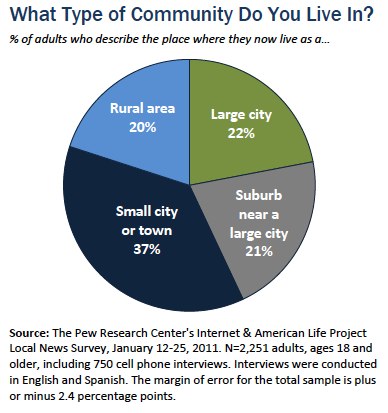
Significant demographic differences across community type
Age of the population is one of the most significant differences across community types. Urban populations skew much younger than those of other types of communities. One-third of urban residents are between 18 and 29 years of age, compared with two in 10 or fewer in each of the other types of communities. More than four in 10 large city residents are “Generation Y” (ages 18-34), which is significantly higher than the proportion of young adults living in other types of communities.
At the other end of the age spectrum, rural community residents tend to be older than those living in more populated areas. In rural areas, half (51%) of the residents are ages 50 or older, including 21% who are 65 or older. In other types of communities, the proportion of residents ages 50 and older is closer to 40% or less. In addition, 26% of rural residents are retired, compared with 20% or fewer residents of other types of communities.
Suburban and small town populations are more evenly distributed across age groups and generations, though populations of small cities and towns skew younger than suburban areas. Next to large cities, small cities and towns have the highest proportion of Generation Y residents.
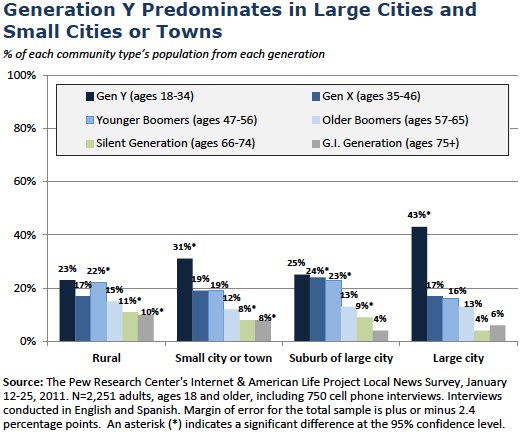
Gender distinctions across community types are small, though urban and rural communities skew slightly male (52% and 53% male, respectively). Suburban and small city/town populations, on the other hand, are disproportionately female (53% and 55% female, respectively).
Suburban residents stand out in their higher education and income levels relative to other types of communities. Suburban residents are the most educated and have the highest reported household income of the four community types. Four in 10 (42%) have a four-year college degree or greater, compared with 30% or fewer in the other three community types. Moreover, 37% report an annual household income of $75,000 or more, much higher than the 20% or fewer residents in other communities reporting that level of income.
In terms of the racial/ethnic makeup of the different populations, rural communities are disproportionately white (82%), while large cities have the highest proportion of both African-American (19%) and Hispanic (22%) residents.

Finally, while residents of each of the four types of communities report attending religious services with the same degree of regularity, their political makeup is quite varied. While large city residents are the most likely to describe themselves as Democrat and politically liberal, residents of small cities/towns are the most likely to identify themselves as politically Independent. Suburban populations skew Republican, as do rural communities. Rural residents are also most likely to say they are politically conservative.
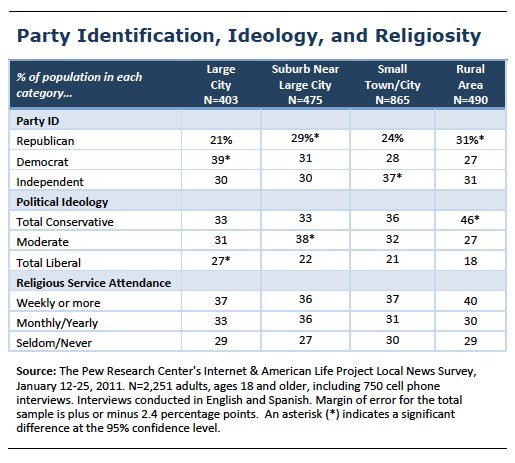
Tech use among residents of different community types
Residents of suburban communities are the most technologically “plugged in.” They are most likely to have a computer, a tablet computer such as an iPad, or a cell phone, and along with urban residents have highest rates of internet and social network site use. Large city residents are second to suburban residents in their rates of computer and cell phone ownership, and are the most likely of all four community types to be Twitter users.
Small town populations fall behind urban and suburban populations but ahead of those living in rural areas in terms of tech gadget ownership and internet use. Not surprisingly, rural residents are the least technologically engaged of the four groups, being least likely to own a computer or cell phone, or to use the internet or social networking sites.

Community involvement across different community types
Residents of rural areas reveal the strongest community ties as measured by their longevity in the community and the fact that they report knowing “all” of their neighbors. They are more likely than residents of other community types to have been in the same community either “all of their lives” or more than 20 years (43% vs. 24% large city, 23% suburbs, 28% small town/city) and they are the most likely of the four groups to know “all” of their neighbors (40% vs. 19% large city, 27% suburban, 28% small town/city).
Large city residents are the least attached to their communities, and are most likely to have lived in their community only a short time and report knowing “none” of their neighbors. Large city residents are also the most likely to express ambivalence about where they live by describing their community as a ‘fair’ or ‘poor’ place to live.
Suburban residents are more positive about their communities and confident in their ability to impact their local area than some of the other community groups. Those living in the suburbs are most likely to rate their community as an “excellent” or “good” place to live, and to say they can have a “big” or “moderate” impact in making their community a better place to live. Rural residents are least likely to feel they can positively impact their community.

General news interest across different community types
Americans in different types of communities across the U.S. are similar in their overall interest in keeping up with the news, and show no significant differences in their interest in following local or international news specifically. More than half of Americans, across all communities, indicate they enjoy keeping up with the news ‘a lot’ (ranging from 53% in small cities to 60% in suburban communities). Similar percentages in all communities say they follow international news closely regardless of what is happening (ranging from a low of 54% in rural communities to 58% in large cities). Interest in national news is significantly higher among suburban residents than other populations, with three-quarters (74%) following national events closely regardless of what is going on, compared with 67% in all other communities.
Interest in local news is also consistently high across different community types. Two-thirds or more of the residents across all types of communities report following local news closely even when nothing important is happening. The lowest level of local new interest is in large cities, where 68% of residents say they keep up with local news regularly. The highest level is in rural areas, with 73% following local events.

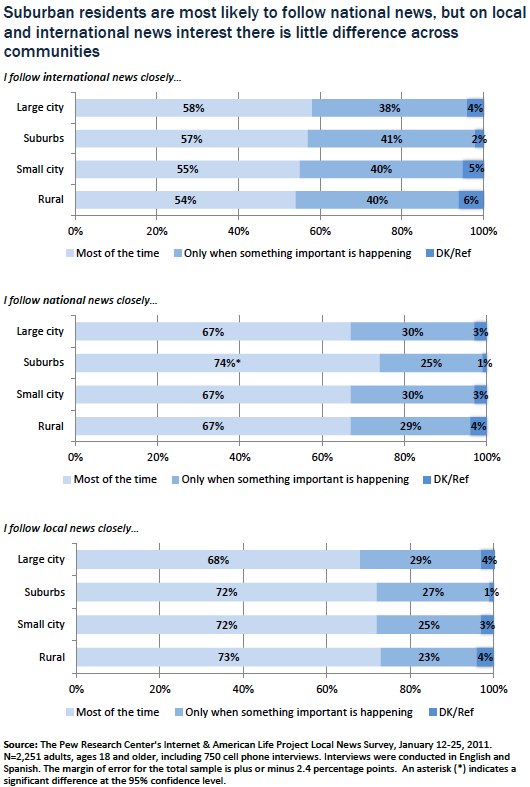
Moreover, residents of these different types of communities are similar in their broad views of the local news environment. There are no statistically significant differences across community types in residents’ preference for a favorite source of local news or in perceptions of how well local news sources provide them with the information they need. Overall, more than half (55%) of adults have a favorite source of local news (this ranges from 53% of rural residents to 58% of urbanites).
On the whole, majorities of adults in all community types report that their local news sources provide all or most of the information that matter to them. Overall, among all adults, about one-third (31%) say local news sources provide all of the information that matters to them, with an additional 58% saying these sources provide at least some of the information they care about (total for the two response categories of 89%). Across different types of communities, results for these two responses combined vary very little, from a low of 87% in rural areas to a high of 91% in large cities, with no significant differences across community types.
However, while slight majorities of residents of large cities, suburbs and small towns all report finding it easier to keep up with local news and information today than it was five years ago, their rural counterparts are significantly less likely to hold this view. While slightly less than half of rural residents (46%) say it is easier today to keep up with local news, the same is true of 59% of large city residents, 60% of adults in the suburbs, and 55% of adults living in small cities and towns. This may be due, in part, to the rural Americans’ reliance on traditional media for gathering news and information. And it might also reflect the relatively limited access their community has to broadband and/or the relative newness of broadband availability. This is discussed below.
Local topics of interest among residents of different communities
In this survey, we asked respondents about whether they followed 16 different news and information topics. The chart below shows their general interest in these topics:
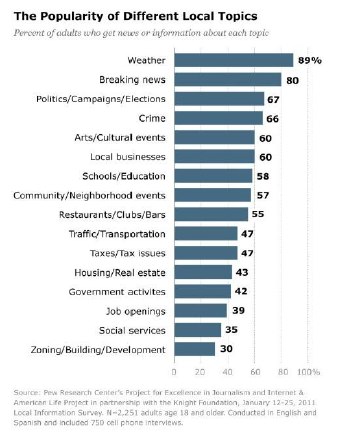
Among all adults, survey data indicated that the most closely followed local topics are weather, breaking news, politics, and crime, all followed by a solid majority of two-thirds or higher. Slightly less popular, but still with a sizeable following of half or more of adults, are arts and culture, local businesses, schools and education, community and neighborhood events, restaurants, taxes, and traffic. Fewer survey respondents follow local news about housing, local government activity, job openings, social services, or zoning. Roughly four in 10 adults or fewer follow these latter local topics.2
In most cases, residents of the four different types of communities do not differ in the local topics they follow. For 11 of 16 local topics asked about, there were no statistically significant differences across community type in the percent of residents who follow each topic.
But there are differences by community type in five of the local news topics we surveyed—arts and culture, local restaurants, traffic, taxes, and housing. With the exception of taxes, rural residents are less likely to follow all of these topics. What is unclear is whether rural residents are less likely to follow these topics because of less intrinsic interest or because these activities are less common or less relevant in their rural community than is the case in urban or suburban communities. Presumably, the latter would offer more choices in these arenas, and would garner more local coverage.
Suburban residents stand out as the most likely to follow news about local tax issues as well as local arts and culture.

Local news sources used across different community types
Number of sources used to follow local topics
Residents of large cities and suburbs use more local news sources each week than do residents of other types of communities. Among suburban and urban populations, about two in 10 residents (20% large city, 18% suburbs) report using six or more sources of local information each week. That figure is about one in 10 among residents of small cities (13%) and rural areas (11%). Moreover, residents of large cities and suburbs use a higher number of local news sources per week (3.6 and 3.7 respectively) than those living in small cities/towns or rural areas (average of 3.3 for each).

Sources of local information used at least weekly
Urban and suburban residents also use a wider variety of local news sources on a regular basis. Close to half of urban (45%) and suburban (51%) residents use a combination of traditional, online and mobile local news media to get their local news, compared with 38% of those living in small cities and 27% of rural residents.
Taken together, small city/town and rural residents are more likely than those in larger cities and suburbs to rely solely on traditional forms of media for their local news. Roughly three in 10 residents in these less populated locales rely exclusively on traditional sources of information such as print newspaper and local television broadcasts (31% and 34%, respectively), compared with 21% of residents of large cities and 16% of those living in suburban communities. This fact may be driven by the tastes of small city and rural residents and might also be affected by the fact that at least in some smaller communities the number of new information sources are limited.

While overall, large city residents are among the most likely to use a combination of all three major types of local news media, they are at the same time the least likely to use some specific traditional sources of local information such as print newspapers and broadcast TV news. Instead, urban residents tend to use online sources of local information such as internet searches, Twitter, blogs, and websites of TV and newspapers. Rural residents, in contrast, are the least likely to look to online sources of local news, not surprising, given their lower tech use relative to other populations.
Urban residents’ reliance on a greater number and diversity of local news sources may result from the fact that urbanites tend to be younger and more tech savvy than their rural counterparts, offering them more avenues through which to gather news and information. Although internet use is widespread across residents of all community types, residents of large cities and suburbs are more likely than those in small cities or rural areas to use the internet. Those in large cities are also more likely to use Twitter than others and rural residents are less likely than those in large cities or the suburbs to be social network users.
Among other findings of note, suburban residents get local information from the radio more than residents in smaller cities (55% vs. 46%). And word of mouth is a more widely used source of local information in both small cities and rural areas than in suburban communities.

How do local newspapers fare in different communities?
There is little difference across residents of different communities in their commitment to their local newspaper or in the impact they anticipate if their local newspaper did not exist. Small city/town residents are most likely (61%) and large city residents least likely (54%) to say there would be an impact if their local newspaper no longer existed, with suburban (59%) and rural (56%) residents falling somewhere between. Large city residents also show less willingness than those in other communities to pay for local news content. They are less likely than residents of any other type of community to have a paid subscription to a local newspaper (22% vs. 40% suburbs, 33% small city, 37% rural), and currently have the lowest level of reported readership on a weekly basis (34% vs. 40% suburbs, 42% small city, 41% rural) . This might stem, in part, from the fact that urban residents have more choices for getting access to information and might need to depend less on a paid-for newspaper to get the material they want.
Putting it all together: How residents in different kinds of communities follow specific local news topics
Taking into account the fact that residents of different community types differ in the local news sources they use in general (with large city residents more likely to use non-traditional forms of media and those in rural areas relying more heavily on traditional forms such as local print newspapers and television broadcasts), this section explores which sources are used to follow specific local types in these different community types.
Large cities
Overall, large city residents prefer non-traditional online sources when getting information about four of the 16 local topics asked about. These urbanites prefer a combination of both traditional and non-traditional media for four additional topics, and for the remaining eight topics rely on more traditional forms of media like print newspapers and television broadcasts. Specifically:
- The Internet is large city residents’ top local news source when getting information about local restaurants (40%), other local businesses (38%), housing issues (22%), and schools (28%)
- A combination of Internet and either print newspaper or television news are the top sources cited by urban residents for following news about local jobs, arts and culture, community events, and taxes
- Television news is urban residents’ preferred source for information about local breaking news (55%), weather (54%), crime (30%), politics (30%), and traffic (21%)
- A combination of traditional forms of media is preferred by urban residents to track information on zoning, social services, and local government issues
Rural areas
In contrast to urban residents, those who live in rural areas are more tied to traditional forms of media for keeping up with local topics of interest. Rural residents follow 12 of 16 topics mainly via traditional media such as print newspapers and local television news, and the remaining four topics through a combination of traditional and non-traditional local news sources. Specifically:
- Print newspapers are the preferred source among rural residents for following community events (28%), crime (41%), taxes (22%), local government (26%), arts and culture (26%), jobs (21%), zoning (19%), and social services (18%)
- Television news is rural residents’ preferred source for local breaking news (55%), weather (64%), politics (34%), and traffic (20%)
- Rural residents rely on a combination of traditional and non-traditional sources for gathering information about local restaurants, other businesses, housing, and schools
Suburbs of a large city
Residents of suburban areas rely on a variety of both traditional and non-traditional local news sources to keep up with local topics. Specifically:
- Suburban residents rely mainly on the internet for following local restaurants (38%), other businesses (30%), and local jobs (22%); they look to television news for weather (54%), and breaking news (62%)
- This group prefers to follow traffic news via television and radio
- Suburbanites rely mostly on local newspapers to follow local crime (35%), taxes (25%), schools (24%), local government (22%), community events (21%), zoning (18%), and housing (25%)
- Finally, this population relies equally on the local newspaper and local television for information about social services (9% television, 9% newspaper), arts and culture (newspaper 28%, television 24%), and politics (television 26%, newspaper 25%)
Small city/town
In small cities and towns, the sources used for following specific local topics are similar to that in rural areas, with fairly heavy preference for traditional sources such as local newspapers and television. These small town residents rely on local television and newspapers to follow 13 of the 16 topics asked about.
- This population prefers the local newspaper for information about the local weather (59%), crime (43%), community events (30%), schools (25%), arts and culture (25%), taxes (24%), housing (21%), zoning (18%), local government (19%), and social services (14%)
- They rely most on television news for local breaking news (53%)
- Small city/town residents rely fairly equally on a combination of traditional sources for traffic and local politics
- For the remaining three topics, small town residents prefer to use the internet (restaurants) or a combination of the internet and more traditional sources (local businesses, jobs)
Leading edge local news consumers: Digital “News participators” and mobile news consumers
Survey respondents were asked if they ever engaged in any of eight online activities related to the consumption of local news content. These items included:
- emailing a link to a local news story or local news video to someone,
- posting news or information about the local community on a social networking site or Twitter,
- commenting on a local news story or local blog online,
- customizing a homepage to include favorite local information or news source or topic,
- contributing to online discussions or message boards about the local community,
- tagging local news content, or
- contributing an article, opinion piece, picture, or video about the local community to an online news site
Respondents who said yes to at least one of these activities are classified as a ‘local news participator.’ Fully 41% of all adults fall into this category.
Suburban residents are more likely than any of the other groups to actively participate in the local news environment, followed by residents of large cities. About half of suburban residents (53%) have participated in some way in sharing or creating local news or information, and 45% of large city residents have taken some action that classifies them as local news participators. In comparison, about one-third of small city or rural residents have participated in one of these activities.
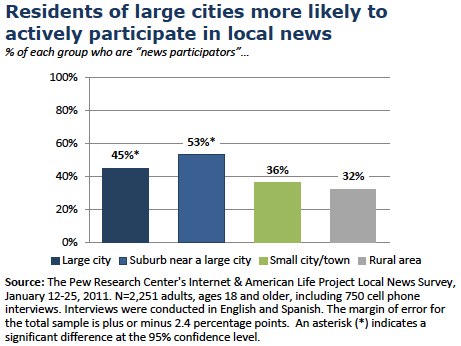
On most of the individual items included in the local news participation measure, large city residents are the most likely to say they have engaged in the activity and rural residents are the least likely. Residents of different types of communities, however, do not differ in the extent to which they contribute their own articles, opinion pieces, or videos about local issues, in their participation in online discussions or message boards, or in customizing a homepage for local news content.

Use of mobile devices (cell phones or tablet computers) to gather news or information online about the local community, local traffic, restaurants and the like is more common among large city and suburban residents than among those in smaller cities or town or rural areas. Overall, more than half of urban (53%) and suburban (57%) residents use a cell phone or tablet computer to get some kind of local news or information online, compared with 45% of small city and 35% of rural residents.
Looking at specific types of mobile news consumption, six in 10 large city and suburban residents use mobile devices to find a local restaurant, compared with half or fewer residents of small cities/towns or rural areas. Those living in the suburbs are most likely to use mobile devices to get coupons or discounts for local stores, while large city residents are most likely to use their mobile devices to get information on local traffic or transportation.





